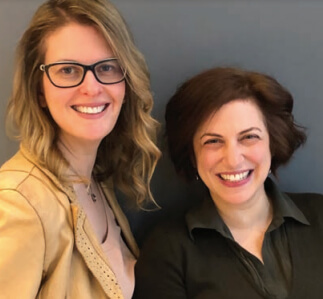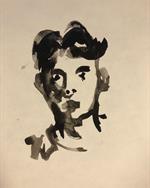Above: Rachel Rafael Neis. Detail from Flight of the Duckfish, 2020. Oil on canvas. 54 in. x 84 in. Courtesy of the artist.

Mira Sucharov & Chaya Halberstam
In this issue we knew we wanted to explore physicality. But it wasn’t easy settling on a title. The phrase “the body” circulates in academia as part of a theoretical orientation to the materiality of what we study, particularly the physicality of our human selves. But we also sensed something uncanny in calling it “The Body Issue.” Our minds wandered first to the dead and then to the bronzed and rippling. But rather than pick something more oblique (The Embodiment Issue? The Corporeality Issue?), we decided to embrace everything “The Body” calls to mind, from invigorating physicality to vanity and performance to disease, death, and decay. Within Jewish Studies there is much to say about this entire range of experience.
Nevertheless, a scholarly “corporeal turn” several decades ago was not universally embraced in Jewish Studies.i It faced resistance, as some in the field insisted that what makes Jewish Studies worthy of attention is its intellectual achievements rather than its more base, bodily realities. These critics were in turn responding to age-old antisemitic accusations of excessive Jewish carnality: Jews are too materialistic, too sexually driven, too embodied. Today, the significance of the Jewish body appears to be widely accepted within Jewish Studies scholarship. Its abilities and limitations; the place of the body in self- and other-identification; the force of affect and emotion; the dynamics of gender, sexuality, reproduction, and physicality; and the ritual importance of bodies—all are now, it seems, comfortably settled within Jewish Studies curricula.
This issue of AJS Perspectivesis devoted to examining the body in a variety of forms and contexts—as a vehicle for artistic expression; as a means of recreation; as a site of violence, power, and control; as a repository for identity roles and performance; and as a brute fact of life and death. We open the issue with two essays on Ottoman Jewish history that serendipitously complement each other: Jewish “marginals” considered deviant and filthy (Bolel) and Jews as a part of a muscular “civic sports culture” (Yıldız). Turning to film, bodies are highlighted in a contemporary Israeli golem allegory (Gershenson) and in taboo-breaking performances by Jewish actresses in Bollywood in the early twentieth century (Greenberg). Early Jewish approaches to affect and the body are then explored (Abate), followed by an analysis of the role of body and biology in halakhic discussions of medically assisted reproduction (Bedzow and Kagedan). How bodies integrate or fail to integrate into ritual and worship spaces is the topic of the next two essays (Milligan, Raucher). The body’s vulnerability to violence and its deterioration into waste and filth bring the issue full circle with essays on domestic violence in the Zohar (Brown), the vile sights and smells of excrement and death in the concentration camps (Levitsky), and resistance and reclamation of the body by survivors (Keller). In some of this work, bodies are being used by the research subjects in purposive ways—for performance, competition, or recreation, for example; in other cases, researchers look to the body to uncover surprising insights into topics once thought purely “of the mind.”
We are pleased to feature a special section on a theme that emerged organically from our call for papers: dance. Choreographed or spontaneous, dance can shape or express Jewishness in a variety of ways. In this issue, authors take on the topic of dance in relation to the immigrant experience, Palestine solidarity, Israeli masculinity, tikkun ʿolam (repairing the world), the search for Jewish roots, and secular Jewish courtship. As always, we are also enthusiastic about offering pieces on pedagogy and the profession. What happens when we invite students to use their bodies—in real or imagined ways—when studying religion and history, or to focus more on the embodied experiences of our subjects of study? How do our bodies skew, for good or for ill, the experiences we have in professional settings? Finally, we are thrilled to feature the artwork of Rachel Rafael Neis—a historian, Talmudist, and artist—throughout the issue. Often inspired by early rabbinic literature, Rachel Rafael Neis’s artwork calls attention to the fleshy and material both in form and content, tending to feature bodies, creaturely hybrids, and interconnected worlds of material life.
We invite readers of “The Body Issue” to consider the Jewish body, and Jews and bodies, throughout history and in current urgent debates in Jewish Studies. We also hope “The Body Issue” will prompt readers to consider their own bodies and how they can help ease the way toward, or hold us back from, full participation in these debates.
Chaya Halberstam
King’s University College
Mira Sucharov
Carleton University
i See Barbara Kirshenblatt-Gimblett, “The Corporeal Turn,” Jewish Quarterly Review 95, no. 3 (2005): 447–61, for a full discussion of this pivotal turn in Jewish Studies.

Featured Artist
Rachel Rafael Neis
purchase artwork